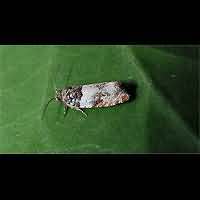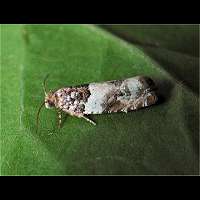Gypsonoma dealbana, a Tortrix Moth
Gypsonoma dealbana is hard to identify at times, for it does look like a number of other Tortricids, especially Gypsonoma sociana. The first part of the upperwings (the shoulder) is marbled, the remainder is greyish white with lots of very variable markings. There is always a dark spot near the tip of the wing. The colour of this spot ranges from ochreous yellow through all kinds of browns to almost black. But that is the same in some other species. To tell them apart you must look at the 'face'. In Gypsonoma sociana the face is snow white, in Gypsonoma dealbana creamish white and much darker in all other species. The front legs are white with grey spots and so is the second pair, but they are ringed near the feet. It is a very small species reaching a wingspan of 11 to 14 mm only.
After hatching in august or september the larvae will mine a leaf, which means they live inside. When growing bigger they move to the underside of the leaf, but they might eat fresh sprouts as well. They hibernate not fully grown. In spring they behave like true leaf rolling moths bij spinning two or more leaves together. The caterpillars are creamy white and have a brown head and brown true feet. Just behind the head there is a dark brown spot divided into two parts by a thin yellowish white line. By the end of May pupation starts, either in leaves spun together or in the soil. The new generation of adult moths will be flying about in June, July and August. The caterpillars are found an various deciduous trees including oak, hawthorn hazel and willow. On the last two they also feed on the catkins.
This species flies from dusk till far after midnight. They are attracted to light in reasonable numbers, usually around midnight. A very common species in England, Wales and Ireland, but getting scarcer to the north. Also a very common species over most of Europe, Northern Asia, Korea and Japan.
Gypsonoma dealbana is hard to identify at times, for it does look like a number of other Tortricids, especially Gypsonoma sociana. The first part of the upperwings (the shoulder) is marbled, the remainder is greyish white with lots of very variable markings. There is always a dark spot near the tip of the wing. The colour of this spot ranges from ochreous yellow through all kinds of browns to almost black. But that is the same in some other species. To tell them apart you must look at the 'face'. In Gypsonoma sociana the face is snow white, in Gypsonoma dealbana creamish white and much darker in all other species. The front legs are white with grey spots and so is the second pair, but they are ringed near the feet. It is a very small species reaching a wingspan of 11 to 14 mm only.
After hatching in august or september the larvae will mine a leaf, which means they live inside. When growing bigger they move to the underside of the leaf, but they might eat fresh sprouts as well. They hibernate not fully grown. In spring they behave like true leaf rolling moths bij spinning two or more leaves together. The caterpillars are creamy white and have a brown head and brown true feet. Just behind the head there is a dark brown spot divided into two parts by a thin yellowish white line. By the end of May pupation starts, either in leaves spun together or in the soil. The new generation of adult moths will be flying about in June, July and August. The caterpillars are found an various deciduous trees including oak, hawthorn hazel and willow. On the last two they also feed on the catkins.
This species flies from dusk till far after midnight. They are attracted to light in reasonable numbers, usually around midnight. A very common species in England, Wales and Ireland, but getting scarcer to the north. Also a very common species over most of Europe, Northern Asia, Korea and Japan.





